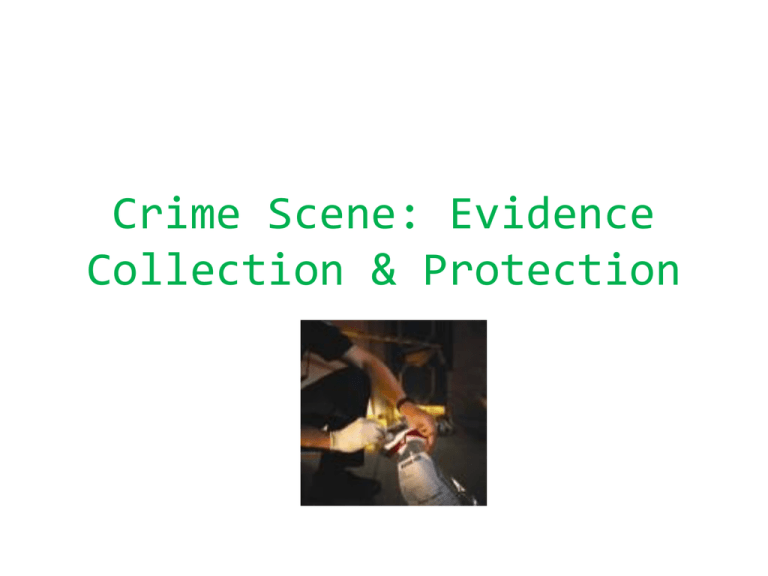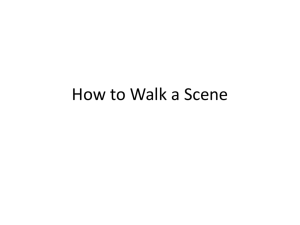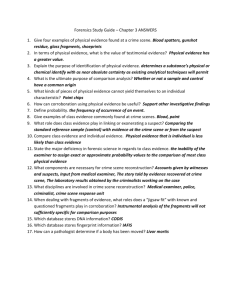Crime Scene: Evidence Collection & Protection
advertisement

Crime Scene: Evidence Collection & Protection I. Assessing the Scene of the Crime • The moment a police officer arrives on the scene, a strict set of guidelines designed to guard evidence against damage, contamination or loss. • Everything that occurs at the scene must be documented. • Failure to secure the scene could result in the perpetrator walking free. Primary and Secondary Crime Scenes • A primary crime scene is where the crime actually occurred. – Typically yields the most useful evidence, but not always • A secondary crime scene is in some way related to the crime but not where the crime took place. – Sometimes the primary crime scene is not known and investigators rely on clues from the secondary crime scene to lead to the place the crime occurred. Preserving and Processing the Crime Scene • 1. The boundaries of the crime scene must be determined and cordoned off. • 2. Only necessary personnel are permitted . – First responding officer establishes a security log. – Remember Locard’s Principal? Every person that enters the scene leaves evidence of their presence and could take away crucial evidence as they leave. • 3. Preliminary walk-through examination – Plans an approach to collection of evidence. Documenting the Procedure • Note Taker-Keeps an accurate account of all activities around the crime scene. – Detailed description of the scene – Accurate list describing each piece of evidence • When, where, and whom it was found by • Who transported it to the lab • Identifies and comments on every photo taken at the scene • Photographer-Photos must be taken as soon as possible before anything is moved to document the scene in an unaltered condition. Documenting the Procedure Cont. – Photos of surrounding area of crime scene is documented. – Close-ups of each Item of evidence is taken, and well as any injuries to the victim. Documenting the Procedure Cont. • Sketcher-Sketches show the relationship of each item of evidence to other items or the body. – Each piece of evidence is mapped to provide exact graphic coordinates – Sketches may be rough but need to be accurate, and can be redrawn later for clarity Example of a Crime Scene Sketch Reconstruction of the Crime Scene • At this point the investigator begins formulating a hypothesis of the crime, focusing on the likely sequence of events and the locations of everyone present at the crime. – Each piece of evidence must support the hypothesis including the results from the crime lab. – Reconstruction is an evolving process as more evidence is found and other evidence is discredited. – An investigator must at all times avoid making assumptions. Recognizing a Staged Crime • Staging is when someone who’s committed a crime attempts to make the scene look like something that it isn’t. – Making a murder look like a suicide – Setting Fire to cover up another crime – Breaking a window or prying a lock to confuse entry. II. Classifying the Evidence • Evidence is anything that can be used to determine whether a crime has been committed – Can link a suspect to the scene – Can Corroborate or refute an alibi or statement – Identify a perpetrator or victim – Exonerate the innocent – Induce a confession Direct or Circumstantial Evidence • Direct Evidence establishes a fact. – Eyewitness statements and confessions – Less reliable and more subjective • Circumstantial Evidence requires a judge, and or jury make an indirect judgment about what happened. – Fingerprints or DNA found at the scene matches the suspects. – More reliable and objective Physical & Biological Evidence • Forensic evidence can be divided into 2 basic categories: – 1. Physical Evidence • Non-living or inorganic items • Fingerprints, tool marks, fibers, drugs, bullets, explosives, fire accelerants – 2. Biological Evidence • Includes organic material • Blood, saliva, urine, hair, botanical materials Associative Evidence • Associative Evidence is evidence that either associates or dissociates the suspect to the crime scene. Class and Individual Evidence • Class characteristics are not unique to a particular object, but place the particular bit of evidence into a group of objects. – Ex: Blood from the suspect found at the scene is found to be ABO type B. Tens of millions of people have this type and could be the possible suspect. • Individual characteristics narrow down the evidence to one person or small group of individuals. – EX: Blood from the suspect found at the scene is put through a DNA fingerprint test will narrow the possible suspects down to one person Analyzing the Evidence at the Crime Scene • 2 Purposes: – 1. Identification • Determines what the item or substance is – 2. Comparison • Find out if a known and a suspect item or substance share a common origin • Linkage-A connection between a suspect and a person, place or object – Connections formed by evidence III. Collecting the Evidence • Searching the area – The way the investigator searches an area depends on its size and physical layout – Investigators typically follow a geometric pattern • • • • Criss-Cross Grid, Shoulder to shoulder linear pattern Spiral pattern is used when expnding out from a body Zones are used for large areas Gathering Evidence • Investigators start with evidences that is the most fragile, or is at risk of being lost. – Blood, fibers, hair, fingerprints…… • Techniques for gathering fragile evidence – Fingerprints are photographed and then lifted – Tool marks, shoeprints, and tire tracks are photographed and the a cast is made – Hairs are found using alternative light source and gathered with tweezers. Packing the Evidence • Dry trace evidence is packed in druggist’s folds or small folded papers. • Documents are sealed in plastic covers. • Liquid evidence is put into unbreakable airtight, sealed containers. • Wet biological evidence such as a bloody shirt is dried to prevent bacterial or mold growth. • Tool marks and bullet holes are processed at the scene Chain of Custody • Continuous records showing that evidence has been kept safe and secure from the crime scene to the lab is vital to the case. • Every person that handles a piece of evidence must be accounted for and properly recorded. • A break in the chain of custody could render the evidence inadmissible by compromising its integrity. Chain of Custody Cont. • Each person who accepts an item of evidence initials and dates it, and then is responsible for maintaining its integrity until it is passed on to the next person. • Police officer finds a shell casing at the scene…. – Collects it, marks it, places it in an evidence bag, then signs it over to an investigator – Investigator signs it over to the lab technician who runs the necessary tests. – Technician then signs it over to the custodian of evidence (Police officer in charge of the secured evidence lock-up area at the police department). – From there it will be signed over to the prosecuting attorny for presentation in court.








